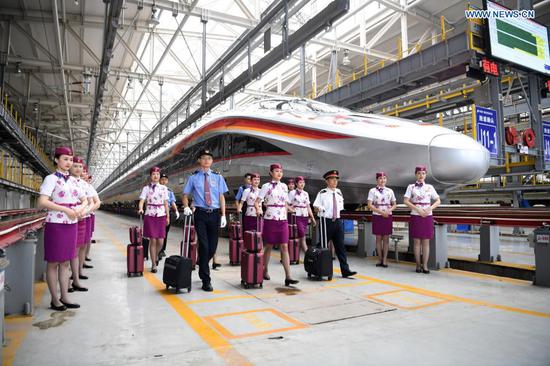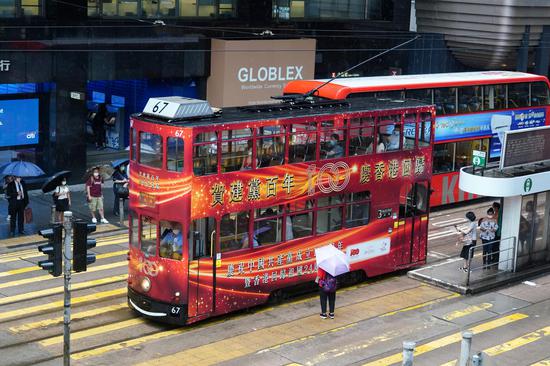
Heavily loaded trucks leave the inland municipality of Chongqing in southwestern China, heading south down the G75, a main national expressway, to coastal ports in the Guangxi Zhuang autonomous region, where their cargo will be loaded onto ships and sent around the world.
Compared with the traditional export route from Chongqing via the Yangtze River to ports in Shanghai, which usually takes 11 to 16 days, the journey to port via the expressway takes one to two days.
The G75 starts in Lanzhou, capital of the northwestern province of Gansu, and ends in the coastal city of Haikou, capital of South China's Hainan province.
The Ministry of Transport says it is one of 11 north-south expressways in China and passes through seven provincial-level regions, including the provinces of Gansu, Sichuan, Guizhou, Guangdong and Hainan, as well as Chongqing and Guangxi.
An important part of the national highway network, the G75 connects inland regions in northwestern and southwestern China with the country's southern coast.
It will eventually run for 2,439 kilometers, with 2,389 km already open to traffic. Two sections in Gansu and Hainan are under construction, with the one in Hainan expected to open next year and the one in Gansu in 2023.
"The expressway has several roles-a shortcut from inland areas to the southern coastal gateway, a fast passage linking two inland regions and also the first expressway in some remote areas," said Wang Hengbin, an official from the ministry's highway bureau. "It is one of the most convenient passages to travel between the northwestern and southwestern regions."
The section linking Chongqing and Sichuan with Guangxi is an important part of the New Western Land-Sea Corridor, Wang said.
Global connections
Li Ping, head of Chongqing Guizhou Expressway, a Chongqing Expressway subsidiary that operates a section of the G75 in the municipality, said the expressway is Chongqing's first high-speed channel to the sea and plays an important role in highway logistics.
He said that promotion of the New Western Land-Sea Corridor, a trade passage connecting inland cities in southwestern China with the world, has seen the number of trucks running on a section of the highway linking Chongqing and Guizhou increase by 43 percent in three years.
"Behind the busy logistics, it reflects that inland areas in the western region have been accelerating to open up," Li said.
Cargo from inland China can be transported to the border via the corridor for shipment to Southeast Asian countries and then on to other parts of the world. Imports can also use the route to enter China.
It has become a major national project and was written into China's 14th Five-Year Plan (2021-25).
Li said that in recent years, the expressway's road surface and tunnels have been improved and more trees and bushes have been planted alongside it, aiming to provide high-quality travel experiences to the public and also boost regional socioeconomic development.
Infrastructure facilities have also been upgraded to better link logistics and industrial parks by allowing larger trucks to pass through.
Li said the company uses a smart platform to monitor and administer tunnels along the section because Chongqing and Guizhou are known for their mountainous terrain.
"The 'smart' expressway has enhanced the management capability of highways in mountainous southwestern areas," he said.
Truck driver Sun Kunyu has witnessed traffic growth along the way.
"The road has become much busier and sometimes crowded," he said.
The 32-year-old has been driving heavily loaded trucks on the expressway for more than a decade, transporting construction materials between downtown Chongqing and Qijiang, a remote district of the municipality.
The round trip takes more than two hours and he usually makes two to three journeys a day.
"The expressway has improved constantly," he said. "When there is a broken section, it will be mended immediately."
Sun earns about 20,000 yuan ($3,100) a month driving trucks and said the six-lane road is "bread" for his family.

Road to wealth
The road not only reaches developed coastal areas leading overseas, but also links to rural roads to benefit countryside residents.
Liang Rong built a garden on a hill at Ersheng township in Chongqing's Banan district that opened to tourists in 2014 and quickly attracted many visitors from the city with its beautiful countryside views of blossoms.
But Liang received many complaints because the 4-meter-wide road down the hill to the garden could not accommodate buses, and two cars could only pass each other slowly, easily leading to traffic jams.
A new 9-meter-wide asphalt road that opened in 2019 has changed the situation and made Liang very happy.
"Visitors can even take buses to our garden," he said, adding that the widened road has led to expansion of the business, which now receives not only individuals and families as tourists but also groups organized by travel agencies.
"The new road connects with expressways such as the G75 and G50 (from Shanghai to Chongqing) to bring visitors from nearby big cities," Liang said.
With people flocking to the garden, locals opened about 30 small hotels to offer them accommodation.
"Local villagers, including me, have become richer thanks to the road," he said.
The ministry said that in some relatively isolated areas, the G75 provided the first fast path to the outside world. Its Longnan section in Gansu is the first highway in the area, making travel between Gansu and Sichuan more convenient.
Several sections in Guangxi are also the first expressway in the region.
Challenging work
The complicated geographic and geological conditions along the expressway posed challenges to its builders and designers, Wang from the ministry said.
Most of it runs through mountainous areas, including those in Gansu, Chongqing and Sichuan.
"It was quite challenging to build tunnels and bridges back in the 1990s and early 2000s," he said.
The geographic conditions were also quite complicated along sections in Guizhou and Guangxi.
Though most of the road has been completed, improvement has never stopped.
"As one of China's earliest expressways, the G75 has been improved over the years," Wang said.
Expansion projects have been carried out to cater to increased traffic on some busy sections, such as those in Chongqing, Guizhou and Guangxi, and the road's condition has also been improved, he added.
Local culture
One of China's longest expressways, the G75 passes many cities and villages, and in the southern section in Guangxi it passes several areas that are home to ethnic groups including the Zhuang, Yao and Miao.
A service area along the expressway between Nanning and Beihai in Guangxi has incorporated elements of "Na" culture, the traditional culture of the Zhuang ethnic group, including selling traditional ornaments and food, as well as displaying cultural exhibits.
It is a promotion to introduce "Na" culture to more people, said Yu Ling, manager of the service area, adding that Zhuang people live nearby.
"Visitors stop at the service area, take a break and get a chance to know the 'Na' culture," she said. "That means the traditions of the Zhuang ethnic group can reach more people via the expressway network."
China opened its first expressway, connecting Shanghai and the satellite town of Jiading, in 1988, when developed countries, such as the United States and Germany, already had expressway networks in place.
Though late to the game, China has caught up fast, and the G75 is part of a freeway network that now spans 160,000 km, ranking first in the world.
The development of the expressway network reflects China's accomplishments in infrastructure construction.
According to a high-profile transport plan, by 2035, China will have built a freeway network that allows residents of most county-level regions to reach an expressway in half an hour.


















































